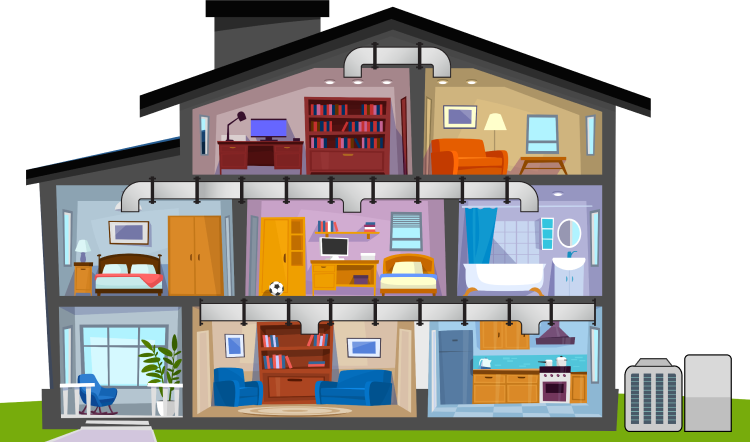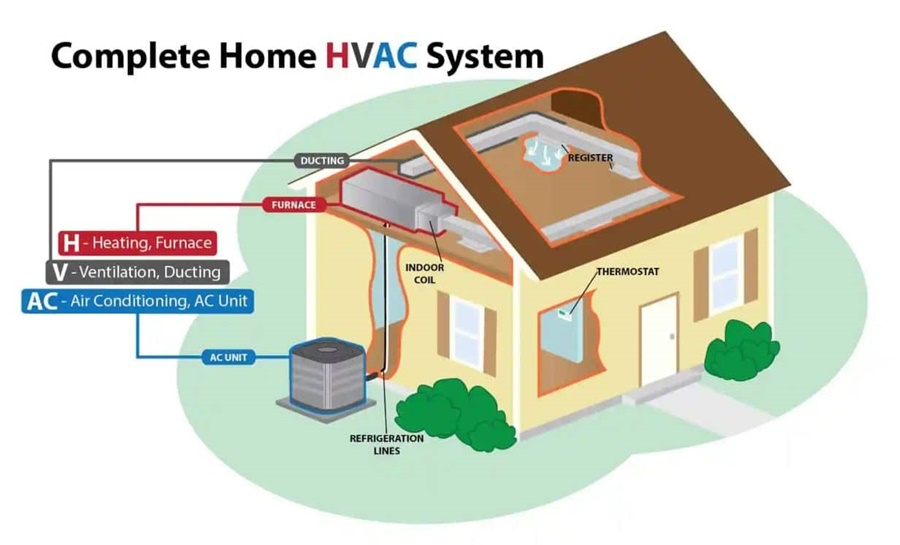When it comes to maintaining a comfortable and healthy living environment, understanding your HVAC system is crucial. HVAC, which stands for Heating, Ventilation, and Air Conditioning, is a technology used in residential buildings to regulate temperature, improve air quality, and control humidity levels. Whether you’re building a new home, renovating, or just looking to understand how your existing system works, this article will guide you through all the essential details about HVAC systems in houses.

Understanding the Basics of an HVAC System
At its core, an HVAC system is responsible for managing the air inside your home. This includes providing heating in winter, cooling in summer, ventilation to ensure fresh air circulation, and humidity control for a healthier indoor environment. These systems can be integrated into one comprehensive unit or may be broken down into separate components, depending on the design and needs of the household.
Components of an HVAC System
A typical home HVAC system consists of the following major components:
1. Heating Unit (Furnace): The furnace heats the air in your home. This can be powered by gas, electricity, or oil, and its main job is to warm the air that circulates through the home.
2. Cooling Unit (Air Conditioner): The air conditioning unit helps to keep the temperature down during hot months. It works by removing heat from indoor air and releasing it outside, providing a cooler and more comfortable living environment.
3. Ventilation System (Ducts and Vents): Ducts and vents allow the distribution of heated or cooled air throughout the home. Proper ventilation ensures that stale indoor air is removed and fresh air enters, promoting healthier living conditions.
4. Air Handling Unit: This component includes a blower, filters, and ductwork to circulate the air throughout the home. It plays an essential role in controlling the flow of air to the various rooms.
5. Thermostat: The thermostat acts as the control center of your HVAC system. It allows you to set the desired temperature and monitor the functioning of both the heating and cooling units.
How Does an HVAC System Work?
The operation of an HVAC system involves a few key steps:
Heating: In the winter, the thermostat triggers the furnace to activate, heating the air. The heated air is then circulated through the home by the blower, passing through the ducts and vents into each room.
Cooling: During warmer months, the thermostat signals the air conditioner to activate. The air conditioner removes warm air from inside the home, cools it, and circulates the chilled air throughout the living spaces.
Ventilation: Ventilation helps in regulating air quality by exchanging indoor air with fresh outdoor air. It can be achieved naturally (through windows and vents) or mechanically (through fans, air handling units, and exhaust systems).
Humidity Control: In addition to temperature control, modern HVAC systems also manage humidity levels. Dehumidifiers and humidifiers may be used to maintain optimal moisture levels, ensuring comfort and preventing mold growth.
Types of HVAC Systems for Homes
Not all HVAC systems are created equal, and the type you choose depends on your needs, the size of your home, and your energy preferences. Here are the most common types of HVAC systems found in residential settings:
1. Split System HVAC
The split system is the most common type used in residential homes. It consists of two main units: an indoor unit (which handles cooling and heating) and an outdoor unit (which removes heat and releases it outside). This type of system is relatively simple to install and is effective for homes of various sizes.
2. Ductless Mini-Split HVAC
A ductless mini-split system is perfect for homes that do not have existing ductwork. It consists of an outdoor unit and one or more indoor air handlers, each serving individual rooms. This allows homeowners to control the temperature in different areas independently, which can improve energy efficiency.
3. Packaged HVAC Systems
In packaged systems, all components (heating, cooling, and ventilation) are combined into one single unit. These systems are often placed on rooftops or outside the home. They are a good option for smaller homes or those looking to save space.
4. Hybrid HVAC Systems
A hybrid HVAC system uses a combination of an electric heat pump and a furnace. This system provides flexibility by switching between the two, depending on the outdoor temperature. During milder weather, the heat pump is used for efficiency, while the furnace kicks in when it’s colder.
5. Geothermal HVAC Systems
Geothermal systems use the earth’s stable underground temperature to heat and cool your home. These systems are highly efficient and eco-friendly but have a higher upfront installation cost. They are particularly effective in areas with extreme temperature fluctuations.
The Importance of Proper HVAC Maintenance
An HVAC system requires regular maintenance to function efficiently and avoid costly repairs. Below are some essential maintenance practices to ensure your system works optimally:
1. Change Filters Regularly
Air filters trap dust, dirt, and debris that would otherwise circulate through your home. Clogged filters reduce airflow, forcing your system to work harder and less efficiently. Make sure to change the filters every 1-3 months, especially during peak heating and cooling seasons.
2. Clean the Ducts
Over time, dust and debris can accumulate in your ductwork, affecting air quality and reducing system efficiency. Have your ducts cleaned periodically by a professional to ensure proper airflow and cleanliness.
3. Inspect the Furnace and AC Units
Regularly inspect your furnace and air conditioning units for any signs of wear or malfunction. This includes checking the thermostat, ensuring that there are no obstructions in the vents, and scheduling annual professional check-ups.
4. Seal Leaks in Ductwork
Leaky ducts waste energy by allowing warm or cool air to escape. Ensure your ducts are sealed properly to maximize energy efficiency and reduce your utility bills.
5. Check Refrigerant Levels
In cooling systems, refrigerant is responsible for absorbing heat from the indoor air. Low refrigerant levels can cause your AC to underperform. A certified HVAC technician can check the levels and recharge the system as needed.
How to Choose the Right HVAC System for Your Home
When selecting an HVAC system for your home, consider the following factors:
Home Size: Larger homes typically require more powerful systems or multi-zone setups. Consult an HVAC professional to ensure you choose a unit that can efficiently handle the space.
Energy Efficiency: Look for energy-efficient units with high SEER (Seasonal Energy Efficiency Ratio) ratings for cooling and AFUE (Annual Fuel Utilization Efficiency) ratings for heating. These systems consume less energy, saving you money in the long run.
Budget: HVAC systems vary in price based on their type and features. Balance your upfront costs with the long-term savings that come from higher efficiency and lower energy consumption.
Climate: Your region’s climate plays a significant role in system selection. For example, if you live in a colder area, a furnace or hybrid system may be more effective than an air conditioner alone.
Conclusion
Understanding your HVAC system is crucial for maintaining a comfortable and healthy home. Whether you are upgrading, replacing, or installing a new system, it is important to consider factors such as system type, energy efficiency, and the size of your home. Regular maintenance also ensures that your HVAC system runs efficiently, saving you money and enhancing your living experience.
